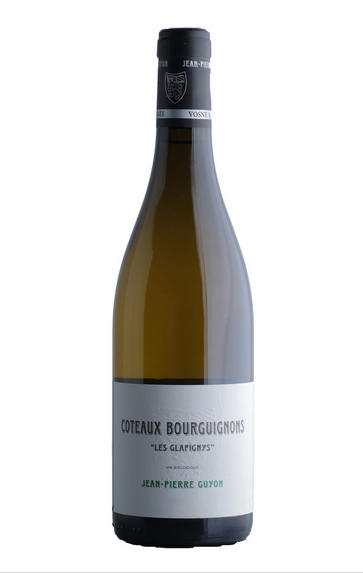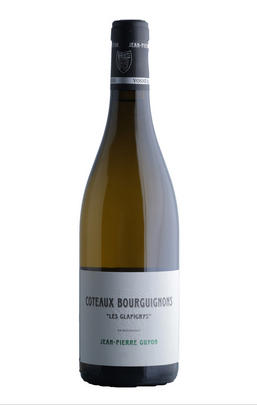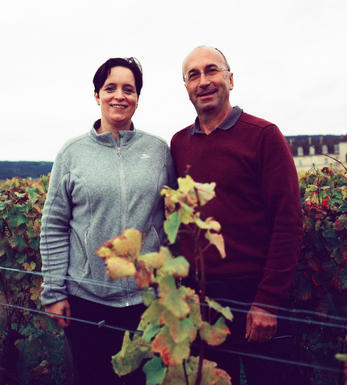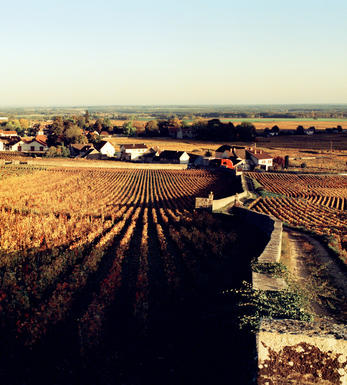
2021 Coteaux Bourguignons, Blanc, Les Glapignys, Domaine Guyon, Burgundy

Critics reviews
Drink 2023-2024
Jasper Morris, Inside Burgundy (January 2023)
About this WINE

Domaine Guyon
The excellent Domaine Guyon in Vosne Romanée has been below most people’s radar – perhaps because Jean-Pierre Guyon spends as much of his time as possible out in the vineyards, which have been farmed organically since 2006, certified from 2012. This is a hugely exciting addition to the Berry Bros. & Rudd range, the wines wowed Jasper Morris MW when he first discovered them. The wines are extraordinarily good, yet are priced very sensibly indeed, a winning combination.
With his high pedigree viticulture as a great starting point, Jean-Pierre can employ whole bunch fermentation as the stalks are ripe, eschewing the use of sulphur at this stage (though some is added later during elevage and at bottling to assure stability). Another point of Guyon’s meticulous care is the use of a vertical press before the juice goes to barrel for 12 months, before racking into older wood for a final six months maturation.
This range of wines is hugely impressive, from the simple Bourgogne Rouge up to the Grand Crus. Finding high quality Vosne Romanée at this pricing level is a rare thing indeed.

Burgundy
Burgundy never quite achieved its political ambitions of being a kingdom in its own right, but for many, the region produces some of the most regal red and white wines in the world.
In Burgundy there are 100 different appellations, numerous individual vineyards and more than 3,000 individual producers. Around 15 million cases are produced annually from 26,500ha of vines in Burgundy, which is usually sub-divided into five regions: Chablis in the Yonne department; the Côte de Nuits and Côte de Beaune in the department of the Côte d'Or; and the Chalonnais and Mâconnais in the Saone-et-Loire.
The world's most famous white wine grape may have originated in Burgundy, where there’s a village called Chardonnay (near Mâcon). This marvellous, full-bodied grape responds well to barrel ageing and can produce wines of great complexity that can age for decades. More often than not though, in recent times, the wines are better enjoyed in their youth. The simpler white wines of Chablis to the north, and the Mâconnais in the south, are usually made in stainless steel to preserve freshness.
The heartland for white Burgundy is the Côte de Beaune with its three great villages, Meursault, Puligny-Montrachet and Chassagne-Montrachet. Here the vineyard classification system really comes into its own. On the flattest land, the wines will be classed only as generic Bourgogne Blanc; as the slope begins to rise, the wines are designated by the name of their village. At mid-slope, the finest vineyards (whose wines are bottled separately) are categorised as Premier Cru (eg Les Charmes) or Grand Cru (Le Montrachet).
Though attractive wines can be found in the Côte Chalonnais (Mercurey, Givry), the great red wines of Burgundy are found in the Côte d'Or. The line of magical villages which constitutes the Côte de Nuits, Gevrey-Chambertin, Morey-St Denis, Chambolle-Musigny, Vougeot, Vosne-Romanée and Nuits-St Georges is practically a roll call of great names. The Côte de Beaune competes through such gems as Volnay and Pommard, which are adjacent yet contrasting villages: lacy elegance for the wines of Volnay, while sturdy and more structured in those from Pommard.
Whereas Burgundy used to be considered a veritable minefield because of the complexity of choice, these days it is more of a playground for the adventurous wine lover, thanks to the vast increase in number of quality-conscious, properly-trained producers.

Chardonnay
Chardonnay is often seen as the king of white wine grapes and one of the most widely planted in the world It is suited to a wide variety of soils, though it excels in soils with a high limestone content as found in Champagne, Chablis, and the Côte D`Or.
Burgundy is Chardonnay's spiritual home and the best White Burgundies are dry, rich, honeyed wines with marvellous poise, elegance and balance. They are unquestionably the finest dry white wines in the world. Chardonnay plays a crucial role in the Champagne blend, providing structure and finesse, and is the sole grape in Blanc de Blancs.
It is quantitatively important in California and Australia, is widely planted in Chile and South Africa, and is the second most widely planted grape in New Zealand. In warm climates Chardonnay has a tendency to develop very high sugar levels during the final stages of ripening and this can occur at the expense of acidity. Late picking is a common problem and can result in blowsy and flabby wines that lack structure and definition.
Recently in the New World, we have seen a move towards more elegant, better- balanced and less oak-driven Chardonnays, and this is to be welcomed.


Buying options
Add to wishlist
Description
This wine comes from an outlying vineyard, sitting between the railway line and airfield near Nuits-St. Georges. The land is low-lying here but there is clay and limestone. The little parcel of 0.15 ha that Jean Pierre has found has a mix of two-thirds chardonnay and one-third pinot blanc, with 50-year-old vines. The enjoyment is all front-loaded with lots of aromatic character and some exotic fruit notes. The palate gives pleasure although the lowly provenance finally wins out on a shortish finish. Nonetheless, this is exceptional for what it is, and where it comes from. Drink 2023-2026.
wine at a glance
Delivery and quality guarantee